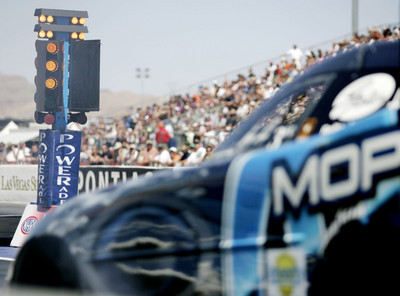Drivers work, play to sharpen reactions

Many adults play video games, but few can honestly say it’s to help their careers.
You might see Top Fuel driver Cory McClenathan sitting in the cockpit of his 330 mph rocket, ignoring the thunder made by cars running on a dragstrip while awaiting his turn.
Fans might be bewildered to see rookie Antron Brown and others sitting in their prone racers on jack stands for up to a half hour, staring at an open briefcase.
Drivers use versions of the NHRA’s starting-line “Christmas Tree” to practice in their pit area, transporter lounge or at home.
Practice might not make a drag racer perfect, but getting close is good enough in a sport in which races can be determined by being the first to leave the starting line.
Drag racers’ quickness off the line, or reaction time, is measured to one-thousandth of a second.
McClenathan said people often ask why he’s playing his hand-held PlayStation game on race days. It will be part of the No. 5 qualifier’s pre-race routine for today’s NHRA SummitRacing.com Nationals at Las Vegas Motor Speedway.
“It’s all about hand-eye coordination, and playing that game helps me get ready,” he said.
Vision is paramount when trying to get the jump on an opponent. When the three yellow LED bulbs activate simultaneously, that’s when pro drivers want to start to leave the line.
The yellows are followed by the green light, but wait until you see green, drivers say, and you’re going to lose.
Brown, a rookie who won the last NHRA Powerade Drag Racing Series event, grew up with starting lines.
But when he was a standout sprinter in high school — running the 100-meter dash in 10.15 seconds — keen ears were almost as important as powerful legs.
When he became a professional drag racer 10 years ago, his vision became the critical sense.
In drag racing, a sequential, electronic lighting system signals the start of each side-by-side contest down the quarter-mile.
As a runner, all you need are shoes, shorts, pavement and maybe a starter’s pistol to simulate a track meet.
It’s not that easy to practice drag racing, so drivers use various methods to simulate the starting-line experience.
Brown will sit in his dragster with a Pingel Eliminator system, which fits into a small briefcase. He attaches it to the throttle pedal to simulate his starting routine.
“I like to do it when the guys are working on the car around me so I can focus on blocking out distractions,” he said.
Other drivers, including Melanie Troxel, have taken parts from crashed race cars to build a cockpit simulator. Troxel and her husband, fellow Funny Car driver Tommy Johnson Jr., use a Portatree timing system similar to Brown’s device.
Anything to get an edge.
“I was quick on my feet and tried to carry that over to my hand-eye coordination,” said Brown, who won 16 titles in Pro Stock Motorcycle before joining David Powers Motorsports this year.
In sprints and drag racing, winners can be determined by fractions of a second, and each form of racing begins from a standing start.
In track, one false start is permitted.
But if a drag racer leaves too soon, it means instant disqualification. Leave too late and he had better be a lot faster than the competition.
Contact reporter Jeff Wolf at jwolf@reviewjournal.com or 702-383-0247.